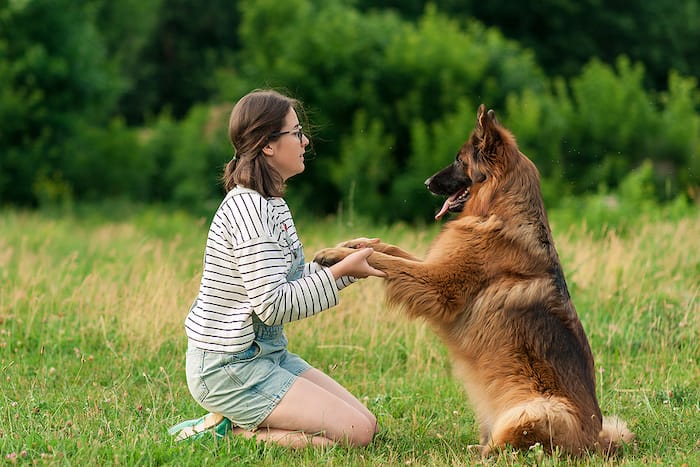As any experienced owner will tell you, desensitizing a new dog to various sounds, sights, and smells is vital for their overall wellbeing and behavior. This process helps to build their confidence, reduces fear-based responses, and promotes calmness in diverse environments. A well-desensitized dog can handle situations like vet visits, grooming, or social gatherings with ease, making such occasions less stressful for the pet and pet-parent alike.

Exposing them gradually to a range of stimuli can help them adapt better to changes in their environment, which is particularly important when your dog is adjust to their new home. Just as we’re sensitive to feeling uncomfortable in a new environment, so are dogs. Especially when it comes to getting used to a new home filled with strange sounds, like the one your pet hair vacuum makes when you turn it on. And just as we take measures to adapt to someplace new, we can take measures to help them do so as well. Have a furry new member of the family who’s struggling to find their groove? Well, here is a simple but helpful guide to desensitizing your dog.
Step One: Understand Before You Undertake
Before you leap into action, it’s best to properly grasp what you’re about to do. And that’s by understanding what desensitization is. At its core, desensitization is the process of making your dog feel comfortable around a stimulus that usually triggers a negative response by exposing them to that stimulus at such a low level that it triggers no response. Over time, you gradually expose your dog to higher levels of the stimulus so that eventually they are comfortable around it.
When your dog’s response—their emotional response—to a particular stimulus changes from a fearful and negative one to a positive and enjoyable one, this is known as counterconditioning. Typically, this involves rewarding your dog with treats each time they are exposed to a higher level of that stimulus. By understanding these techniques—albeit in a basic way—you put yourself in the best position to successfully bring about worthwhile change in your dog’s behaviour.
Step Two: Pay Attention To The Details
It’s all well and good to understand what needs to be done. However, that knowledge will gather dust in the back of your mind if you don’t identify what is spooking your dog. While at first it may seem as though everything is a trigger, the more time you spend with them and the more aware you are of what’s around you when they have an episode, the more likely you are to find the culprit.
Which can prove tricky. And timely. If you’re lucky, you’ll find it’s a certain sound only—like the washing machine or the garage door opening—that scares them. If you’re not, you might find a number of things responsible. If this is the case, remember to be patient and try to identify each trigger one by one. That way, you can remedy each one properly, rather than try to adopt a one-approach-fits-all to your dog’s woes.

Step Three: Find Their Threshold
Once you find what really gets under your dog’s skin, you then need to work out what their threshold is. In other words, find the level where your dog doesn’t react negatively to that stimulus. By finding their threshold, you give yourself a starting point for the desensitisation process. You also give yourself a way to measure your dog’s progress, as the more comfortable they get around the stimulus, the higher their threshold will become.
Step Four: Training Time
When you know your dog’s threshold, you can start desensitising them. For example, say your dog freaks out anytime someone knocks at the front door. Start by lightly knocking on another door that is far from the front door and out of sight of your dog. If they bark, you’re knocking too loudly. Remember, you need to use their threshold as a marker. Once you find the right volume, appear and give them a treat.
Next, move somewhere slightly closer to the front door and repeat the process. Again, reward your dog with a treat. If all goes smoothly, you should find that you’re eventually able to knock on the front door from the outside and enter without your dog freaking out. Again, your patience will be rewarded, so make sure you set aside a generous amount of time for this task. Also, be aware that you may not reach this outcome on the first attempt, so don’t feel disheartened if it takes a few goes before your dog is comfortable with you coming home from work.
The proven way to do this is to give your dog special treats in the beginning, then gradually give them less-special treats as they become more used to the sound. This helps to avoid your dog expecting their favorite snack all day, everyday.

Step Five: Know Your Limits.
The reality is, for all your patience and hard work, there’s a chance your dog won’t get better. Which is okay. The same way it can be difficult to conquer your own phobias, it can be equally as difficult helping your dog conquer theirs. The important thing to remember is that it’s not a poor reflection on you or your methods; rather, it’s a sign that you need to seek professional help. Enlisting someone whose job is to help pets live their best lives will not only help your dog do just that, it will take away the nerves and stress you’ve no doubt been carrying with you through the entire process.
In the end, there is no fixed antidote for curing a dog’s fears and anxieties. You’re dealing with emotions, and emotions are often immune to rigid agendas. That said, if you’re patient with your dog and flexible in your approach, there’s a good chance you’ll find a way to make them feel comfortable in their own skin, all the time. And when you reach that point together, you can relax your faces and get back to having fun again. Good luck!
Related Reading
